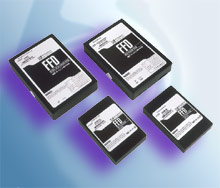|
 What
Is FFD? What
Is FFD?
What
is the same size as a hard drive, the same shape as a hard drive,
has the same connectors as a hard drive, has the same memory
as a hard drive, looks to the system just like a hard drive, but
is 200 times as expensive? The answer is Fast Flash Disk. Basically,
FFD is a flash memory array packaged as a plug-n-play, drop in
replacement for an IDE or SCSI drive. Capacities range from 32
MB to 10.2 GB. So, for all that money, there must be some good
points, right?
The
Good Points
Since
FFD is all solid state, there are no moving parts. No moving parts
means no seek time, no read/write latency. Access time runs less
than 0.1ms. No moving parts means high reliability; 99.999%, to
be exact. And high reliability is maintained even with an unstable
power supply. MTBF is calculated at 2,000,000 hours. (What is
that, 228 years?) Superior reliability means no maintenance required.
All solid state means shock resistant. These things can withstand
50Gs for 11ms, and 1500Gs for 0.5ms. Vibration resistance is also
high (16.4G RMS). They comply with MIL-STD-810E, and with telecommunications
NEBS Level 3. And unlike traditional magnetic hard disks, they
are very resistant to magnetic fields. One peculiar feature of
FFDs, of interest for some very specialized applications, is security
erase. FFDs can completely erase their entire load of information
in about 5 seconds. Just the thing if the enemy is at the gate.
Standard models operate in temperatures of 0 ~ 70° C. Extended
protection models can withstand operating temperatures of -40
~ 85° C. There is also an anticorrosive option with special coatings
on the internal PCBs. These units operate well even in marine
atmospheres.
The
Medium Points
While
seek time is very good, read/write speed for FFD is nothing special.
For IDE FFDs, sustained read/write is around 3.5 MB/sec, with
burst rate at 16.7 MB/sec. For SCSI FFDs, sustained read/write
comes in at under 4 MB/sec, with burst at 9.7 MB/sec. Ultra Wide
SCSI FFDs show sustained read at 28.5 MB/sec, sustained write
23.5 MB/sec, and burst at 40 MB/sec. Reading endurance is unlimited.
Endurance for write/erase cycles is 250,000 to 1,000,000. The
former limiting factor for flash memory, as you may know, was
cell burnout. FFD overcomes this through balanced write management,
or what they call "Dynamic Wear Leveling." The warranty is 5 years.
The
Bad Point
The
bad point is, well, the price.
Applications
FFD
boasts an impressive list of customers, including dozens of big
names we're sure you've heard of. And where do these famous players
deploy their FFDs? Airborne radar, black boxes, in-flight map
displays, ground-based telecom systems, broadcast systems, wireless
base stations, mobile video stations, audio/video servers, military
control systems for radar, sonar, and fire control; factory automation,
robot control, nuclear systems control, and mining test equipment,
to name a few. And since the form factors of FFDs exactly mimic
standard drives, the retrofit market is wide open, especially
for mission-critical applications.
Product
Range
|
FFD
2.5" IDE |
FFD
2.5" SCSI |
FFD
3.5" SCSI |
FFD
3.5" Ultra Wide SCSI |
| capacities |
64MB~4.1GB |
32MB~5.3GB |
32MB~5.6GB |
256MB~10.2GB |
| package
heights |
17mm
up to 4.1GB
12mm
up to 2.3GB
8mm
up to 1.0GB
|
17mm
up to 5.3GB
12mm
up to 2.8GB
8mm
up to 1.0GB
|
|
|
Conclusion
If you
need state-of-the-art mass memory, that offers great performance,
great reliability, zero maintenance, operates well under harsh
conditions, and you can pay a little more (okay, a whole lot more),
FFD is for you.
Find Out More
To
find out more about how Advantech puts cutting edge technology
to work, contact your Advantech representative today, or check
out the Advantech website at www.advantech.com
|

